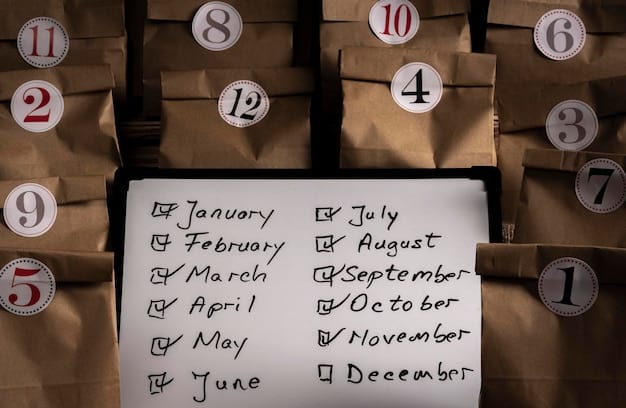Decoding Coupon Fine Print: Save Money by Avoiding These Mistakes

Decoding coupon fine print is crucial for maximizing savings; understanding common restrictions and exclusions can prevent unexpected disappointments at checkout and ensure you get the discounts you expect.
Navigating the world of coupons can feel like a treasure hunt, but it’s easy to stumble if you don’t understand the rules. Decoding coupon fine print is essential to avoid common mistakes and ensure you actually save money instead of facing unexpected costs or invalid discounts.
Understanding the Basics of Coupon Fine Print
Before diving into the specifics, it’s important to understand why coupons have fine print and what it generally covers. This knowledge helps set the stage for avoiding costly errors and making the most of your savings opportunities.
Why Coupons Have Fine Print
Coupon fine print exists to protect the retailer or manufacturer from misuse and to clarify the terms of the offer. It prevents fraud, manages inventory, and ensures that discounts are applied correctly. Without these restrictions, couponing could become unsustainable for businesses.
Common Elements Found in Fine Print
The fine print typically includes several key elements, such as expiration dates, product restrictions, and geographical limitations. There might also be stipulations regarding whether the coupon can be combined with other offers. Familiarizing yourself with these elements is the first step in effective coupon use.
- Expiration Dates: Know when the coupon expires to avoid disappointment at the checkout.
- Product Restrictions: Understand which specific products the coupon applies to.
- Geographical Limitations: Be aware of any regional restrictions on where the coupon can be used.
By understanding the basic reasons behind coupon fine print and the common elements it contains, you’re better prepared to tackle the complexities and avoid potential pitfalls. This knowledge will help you read coupons more critically and use them more effectively.
Mistake #1: Ignoring the Expiration Date
One of the most common mistakes in couponing is overlooking the expiration date. This seemingly obvious detail can lead to significant frustration and wasted effort. Always check the expiration date before planning your shopping trip to ensure your coupons are still valid.
Why Expiration Dates Matter
Expiration dates are in place because promotions are often time-sensitive. Retailers and manufacturers use these dates to control the distribution and redemption of coupons. Offers are designed to boost sales within a specific period, and once that period ends, the coupon is no longer valid.
How to Keep Track of Expiration Dates
Keeping track of expiration dates can seem daunting, but there are several strategies to simplify the process. One method is to organize coupons by expiration date, either in a physical binder or using a digital coupon management app.
- Use a Coupon Organizer: A physical or digital organizer helps you visually track expiration dates.
- Set Reminders: Use your phone or calendar to set reminders for expiring coupons.
- Regularly Purge Expired Coupons: Make it a habit to remove expired coupons to avoid confusion.

Ignoring the expiration date can negate all the effort you put into finding and clipping coupons. By developing effective tracking habits, you can ensure that your coupons are always used before they expire, maximizing your savings.
Mistake #2: Misunderstanding Product Restrictions
Another frequent error is misunderstanding or overlooking the product restrictions outlined in the coupon’s fine print. These restrictions specify exactly which items the coupon is valid for, and failing to heed them can lead to disappointment at the checkout.
Types of Product Restrictions
Product restrictions can come in various forms, including specific brands, sizes, flavors, or even formulations. Some coupons may only apply to a particular product line or require the purchase of multiple items to activate the discount.
- Brand Specifics: The coupon may only be valid for a particular brand, like “only valid on Brand X.”
- Size Limitations: The coupon might specify a certain size, such as “valid on 12 oz. bottles.”
- Flavor Exclusions: Certain flavors might be excluded, like “excludes limited edition flavors.”
Carefully reading the fine print to identify these restrictions is critical. Not doing so can result in the coupon being rejected, leaving you to pay full price or scramble for an alternative.
Tips for Identifying Product Restrictions
To effectively identify product restrictions, train yourself to look for key phrases and terms. Words like “only,” “excludes,” and “specific size” are red flags that indicate restrictions are in place.
Additionally, pay close attention to any model numbers or UPC codes listed on the coupon. These codes provide exact specifications for the eligible products. Comparing these details to the items you’re purchasing can prevent errors and ensure you get the intended discount.
Understanding and adhering to product restrictions is vital for successful couponing. Always double-check the fine print to confirm that your chosen items perfectly match the coupon’s requirements, saving you both money and frustration.
Mistake #3: Overlooking Quantity Limits and Purchase Requirements
Quantity limits and purchase requirements are frequently overlooked aspects of coupon fine print. These stipulations dictate how many items you need to buy or how many coupons you can use in a single transaction. Ignoring these rules can lead to unexpected costs and invalidated coupons.
Understanding Quantity Limits
Quantity limits specify the maximum number of items you can purchase with a single coupon or the maximum number of coupons you can use for the same item. These limits are often stated as “Limit one coupon per purchase” or “Limit four like coupons per household per day.”
Exceeding these limits will result in the extra coupons being rejected. Retailers enforce these limits to prevent bulk purchases intended for resale, ensuring that the discounts benefit individual consumers.
Deciphering Purchase Requirements
Purchase requirements mandate that you buy additional items to qualify for the coupon discount. These requirements can appear as “Buy one, get one free” or “Spend $25, get $5 off.” Failing to meet the stipulated purchase threshold will make the coupon invalid.
Sometimes, purchase requirements can be complex, involving multiple products across different categories. Always read the fine print carefully to understand the full scope of the required purchase.

Strategies for Adhering to These Rules
Keeping track of quantity limits and purchase requirements requires careful planning. Before heading to the store, compile a list of the coupons you plan to use and note any specific purchase conditions. This helps you avoid errors at the checkout.
- Prepare a Shopping List: List the required items and quantities for each coupon.
- Double-Check Before Checkout: Review your cart to ensure you meet all purchase requirements.
- Separate Transactions: If possible, split your purchases into multiple transactions to maximize coupon usage.
Paying close attention to quantity limits and purchase requirements is crucial for successful couponing. Always read the fine print and plan your shopping trip accordingly to make the most of your discounts.
Mistake #4: Ignoring Restrictions on Combining Coupons
Many shoppers fail to check whether coupons can be combined with other offers, potentially missing out on additional savings or facing issues at the checkout. Understanding the rules around coupon stacking is key to maximizing your savings.
Understanding Coupon Stacking
Coupon stacking refers to the practice of using multiple coupons on a single item or transaction. Retailers have different policies regarding this; some allow it, while others strictly prohibit it. Restrictions are usually outlined in the fine print.
Common restrictions include stipulations against combining manufacturer coupons with store coupons or using multiple coupons for the same item. Ignoring these rules can lead to one or more coupons being rejected.
How to Determine if Coupons Can Be Combined
To determine if coupons can be combined, carefully read the fine print on each coupon. Look for specific statements regarding combinability, such as “Cannot be combined with other offers” or “May be combined with one store coupon.”
Navigating Store Policies on Coupon Stacking
Even if the coupon fine print allows for stacking, it’s essential to understand the store’s specific coupon policy. Some stores have stricter rules than what’s printed on the coupon. Check the store’s website or ask a customer service representative for clarification.
Always check the fine print and store policies before attempting to combine coupons. Understanding these rules helps you avoid misunderstandings and maximize your savings through smart coupon usage.
Mistake #5: Neglecting Geographical Limitations
Geographical limitations are often overlooked in coupon fine print, leading to confusion and wasted effort for shoppers. These restrictions specify where the coupon is valid, and ignoring them can render your coupon useless.
Identifying Geographical Restrictions
Geographical restrictions define the regions or stores where a coupon can be used. These limitations might be based on specific countries, states, cities, or even individual store locations. The fine print typically indicates these restrictions with phrases like “Valid only in the US” or “Redeemable at participating locations only.”
It’s crucial to verify that the coupon is valid in your area before planning your shopping trip. Trying to use a coupon outside its designated region will result in rejection at the checkout.
How to Verify Coupon Validity in Your Area
To verify coupon validity, start by carefully reading the fine print for any geographical specifications. Look for explicit mentions of regions or stores where the coupon is accepted. If the restriction is unclear, check the retailer’s website or contact customer service for clarification.
- Check the Fine Print: Look for mentions of specific regions or stores.
- Visit the Retailer’s Website: Check for a list of participating locations.
- Contact Customer Service: Ask for clarification on geographical restrictions.
Always confirm that your coupons are valid in your area to avoid frustration and wasted effort. By taking a few extra moments to verify geographical limitations, you can ensure a smooth and successful couponing experience.
| Key Point | Brief Description |
|---|---|
| 📅 Expiration Dates | Always check the expiration date to ensure coupons are valid. |
| 📦 Product Restrictions | Understand specific product brands, sizes, and flavors allowed. |
| 🔢 Quantity Limits | Adhere to maximum items per coupon or coupons per transaction. |
| 📍 Geographical Limits | Verify coupon validity in your specific region or store location. |
FAQ
▼
Coupon stacking refers to using multiple coupons on a single item or transaction. Policies vary among retailers; some permit it, while others do not. Always check the coupon’s fine print and store policies.
▼
Geographical restrictions are usually stated in the fine print. Look for phrases indicating specific regions or stores. If unclear, check the retailer’s website or contact customer service.
▼
First, ensure the coupon is valid and that you’ve met all requirements. If it still doesn’t scan, ask a cashier or manager for assistance. They may be able to manually override the system.
▼
“BOGO” stands for “Buy One, Get One.” These offers often come with specific stipulations, such as buying two identical items or purchasing a full-priced item to get one free.
▼
Generally, no. Expired coupons are no longer valid and will not be accepted at checkout. Always check expiration dates to avoid disappointment. Some stores may have grace periods, but this is rare.
Conclusion
Decoding the fine print of coupons is a critical skill for any savvy shopper looking to maximize savings. By avoiding these 5 common mistakes – ignoring expiration dates, misunderstanding product restrictions, overlooking quantity limits, neglecting combination restrictions, and disregarding geographical limitations – you can ensure a smoother, more rewarding couponing experience and keep more money in your pocket.





